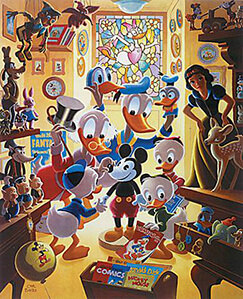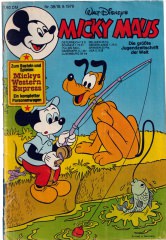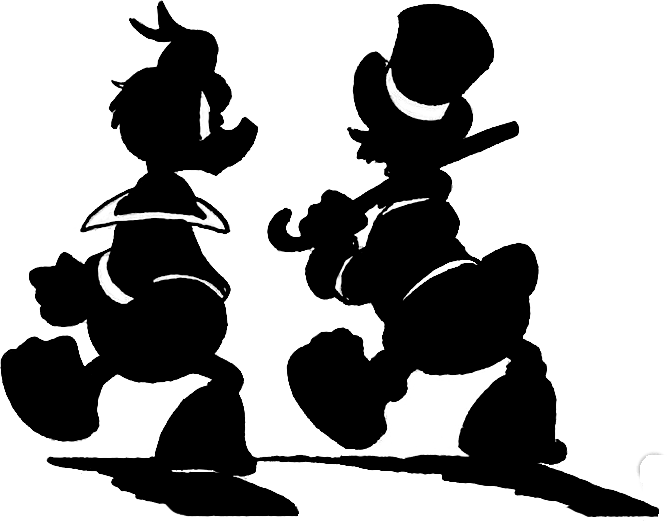
Products description
Disney Dons Dogtags. The Best of Disney Military Insignia from World War II by Walton Rawls. Foreword by David R. Smith, Disney archivist.
Swamped in World War II with requests from the military to use the world-famous Disney characters in creating distinctive unit insignia, the Disney Studio had to set up a special five-man crew of artists to meet the demand for designs. "They meant a lot to the men who were fighting," said Walt Disney. "How could you turn them down?" Imaginative, colorful, and well-executed, these insignia occupy a unique place in Disney history.
Over a five-year period, as a contribution to the war effort, the Studio created some 1,200 insignia, the best of which have been selected for this volume - the first comprehensive survey of this relatively unknown body of Disney art. For the most part, these delightful designs exist today only as fifty-year-old color transparencies or black-and-white photos in the Disney Archives, the originals having been sent directly to their respective units during the war. Nevertheless, period reproductions of the originals can still be found in wartime Disney comic books, on matchbook covers, poster stamps, and, indeed, the leather and woven patches that were inspired by the art - all of which are now very collectible.
It is a tribute to the success of the Disney animators in giving believable personalities to "drawings that move" that some well-known cartoon figures were suitable for military service while others were not. For instance, Donald Duck appeared in more than two hundred designs - his famous temper fit him for militant postures - while the lovable, bashful Mickey Mouse was rarely called upon except for home front causes. Where no Disney character quite fit the bill, the studio happily created new ones, as in the case of the well-known symbols for the Flying Tigers, the Mosquito Fleet, and the Seabees.
In addition to being of interest to Disney enthusiasts and collectors - imagine, after all these years, opening a treasure trove of forgotten Disney artwork - this book definitely will appeal to military buffs and veterans.
Swamped in World War II with requests from the military to use the world-famous Disney characters in creating distinctive unit insignia, the Disney Studio had to set up a special five-man crew of artists to meet the demand for designs. "They meant a lot to the men who were fighting," said Walt Disney. "How could you turn them down?" Imaginative, colorful, and well-executed, these insignia occupy a unique place in Disney history.
Over a five-year period, as a contribution to the war effort, the Studio created some 1,200 insignia, the best of which have been selected for this volume - the first comprehensive survey of this relatively unknown body of Disney art. For the most part, these delightful designs exist today only as fifty-year-old color transparencies or black-and-white photos in the Disney Archives, the originals having been sent directly to their respective units during the war. Nevertheless, period reproductions of the originals can still be found in wartime Disney comic books, on matchbook covers, poster stamps, and, indeed, the leather and woven patches that were inspired by the art - all of which are now very collectible.
It is a tribute to the success of the Disney animators in giving believable personalities to "drawings that move" that some well-known cartoon figures were suitable for military service while others were not. For instance, Donald Duck appeared in more than two hundred designs - his famous temper fit him for militant postures - while the lovable, bashful Mickey Mouse was rarely called upon except for home front causes. Where no Disney character quite fit the bill, the studio happily created new ones, as in the case of the well-known symbols for the Flying Tigers, the Mosquito Fleet, and the Seabees.
In addition to being of interest to Disney enthusiasts and collectors - imagine, after all these years, opening a treasure trove of forgotten Disney artwork - this book definitely will appeal to military buffs and veterans.
Antiquarian
Condition 0 (mint MT)
An exceptional example of a given book. Bindery or printing defects are allowed. Cover is flat with no surface wear. Inks are bright with high reflectivity. Corners are cut square and sharp. Spine is tight and flat. Paper is white, supple and fresh. No interior autographs or owner signatures.
Condition 0-1 (near mint NM)
Nearly perfect in every way with only minor imperfections that keep it from the next higher grade. Only subtle bindery or printing defects are allowed. Cover is flat with no surface wear. Inks are bright with high reflectivity and minimal fading. Corners are cut square and sharp. Small, inconspicuous, lightly penciled, stamped or inked arrival dates are acceptable as long as they are in an unobtrusive location. Spine is tight and flat. Paper is white, supple and fresh. Only the slightest interior tears are allowed.
Condition 1 (very fine VF)
An above-average copy that shows minor wear but is still relatively flat and clean with outstanding eye appeal. A small accumulation of minor bindery/printing defects is allowed. Minor cover wear beginning to show, possibly including minor creases. Corners may be blunted. Stamped or inked arrival dates may be present. Minor foxing. Paper is cream to tan. Centerfold is mostly secure. Minor interior tears at the margin may be present.
Condition 1-2 (fine FN)
An above-average copy that shows minor wear but is still relatively flat and clean with no significant creasing or other serious defects. Some accumulation of minor bindery/printing defects is allowed. Minor cover wear apparent, with minor to moderate creases. Inks show a significant reduction in reflectivity. Blunted corners are more common, as is minor staining, soiling, discoloration, and/or foxing. Stamped or inked arrival dates may be present. Paper is tan to brown and fairly supple with no signs of brittleness. Minor interior tears at the margin may be present. Centerfold may be loose.
Condition 2 (very good/fine VG-FN)
An above-average but well used book. An accumulation of bindery/printing defects is allowed. Minor to moderate cover wear apparent, with minor to moderate creases and/or dimples. Inks have moderate to low reflectivity. Blunted corners are increasingly common, as is minor to moderate staining, discoloration, and/or foxing. Stamped or inked arrival dates may be present. Paper is tan to brown with no signs of brittleness. Centerfold may be loose. Minor interior tears may also be present.
Condition 2-3 (very good VG)
The average used book. Cover shows moderate to significant wear, and may be loose but not completely detached. Cover reflectivity is low. Can have moderate creases or dimples. Corners may be blunted. Store stamps, name stamps, arrival dates, initials, etc. have no effect on this grade. Some discoloration, fading, foxing, and even minor soiling is allowed. As much as a 1/4" triangle can be missing out of the corner or edge; a missing 1/8" square is also acceptable. Moderate spine roll may be present and/or a 1" spine split. Paper is brown but not brittle. Minor to moderate interior tears may be present. Centerfold may be loose or detached at one staple.
Condition 3 (good GD)
Cover shows significant wear and may even be detached. Cover reflectivity is low and in some cases completely absent. Book-length creases and dimples may be present. Rounded corners are more common. Moderate soiling, staining, discoloration and foxing may be present. The largest piece allowed missing from the front or back cover is usually a 1/2" triangle or a 1/4" square. Tape and other forms of amateur repair are common in older books. Spine roll is likely. May have up to a 2" spine split. Paper is brown but not brittle. Centerfold may be loose or detached. Moderate interior tears may be present.
According to § 19 UStG., we charge no sales tax
modified eCommerce Shopsoftware © 2009-2024
modified eCommerce Shopsoftware © 2009-2024



 Contact
Contact





